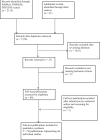Drug interactions between hormonal contraceptives and antiretrovirals
- PMID: 28060009
- PMCID: PMC5378006
- DOI: 10.1097/QAD.0000000000001392
Drug interactions between hormonal contraceptives and antiretrovirals
Abstract
Objective: To summarize published evidence on drug interactions between hormonal contraceptives and antiretrovirals.
Design: Systematic review of the published literature.
Methods: We searched PubMed, POPLINE, and EMBASE for peer-reviewed publications of studies (in any language) from inception to 21 September 2015. We included studies of women using hormonal contraceptives and antiretrovirals concurrently. Outcomes of interest were effectiveness of either therapy, toxicity, or pharmacokinetics. We used standard abstraction forms to summarize and assess strengths and weaknesses.
Results: Fifty reports from 46 studies were included. Most antiretrovirals whether used for therapy or prevention, have limited interactions with hormonal contraceptive methods, with the exception of efavirenz. Although depot medroxyprogesterone acetate is not affected, limited data on implants and combined oral contraceptive pills suggest that efavirenz-containing combination antiretroviral therapy may compromise contraceptive effectiveness of these methods. However, implants remain very effective despite such drug interactions. Antiretroviral plasma concentrations and effectiveness are generally not affected by hormonal contraceptives.
Conclusion: Women taking antiretrovirals, for treatment or prevention, should not be denied access to the full range of hormonal contraceptive options, but should be counseled on the expected rates of unplanned pregnancy associated with all contraceptive methods, in order to make their own informed choices.
Figures
References
-
- DeFranco EA, Seske LM, Greenberg JM, Muglia LJ. Influence of interpregnancy interval on neonatal morbidity. Am J Obstet Gynecol 2015; 212:386.e381–386.389. - PubMed
-
- Ngo AD, Roberts CL, Figtree G. Association between interpregnancy interval and future risk of maternal cardiovascular disease – a population-based record linkage study. BJOG 2016; 123:1311–1318. - PubMed
Publication types
MeSH terms
Substances
Grants and funding
LinkOut - more resources
Full Text Sources
Other Literature Sources
Medical


